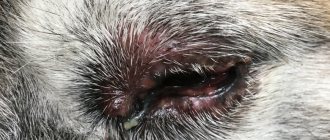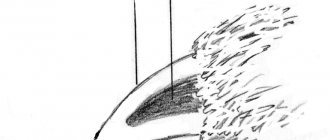Alena Igorevna Goncharenko
veterinarian Petstory
Gingivitis in dogs is a disease of the mouth that is characterized by inflammation of the gums. This disease occurs quite often in dogs, and older pets are especially susceptible to it. Most often, gingivitis occurs against the background of some other pathological change in the body. In this article we will analyze the possible causes of the disease, and most importantly, we will consider how and how to treat gingivitis in dogs.
- Periodontal diseases
- Veterinary assistance
Gingivitis in dogs: the main thing
- Gingivitis in dogs is manifested by redness of the gums, an unpleasant odor from the mouth, and pain when eating solid food.
- The most common cause is dental disease. Less common are viral, fungal, autoimmune and other causes.
- Most often, gingivitis occurs in a chronic form with a slow progression of the disease.
- Treatment is aimed at eliminating the infection and healing damaged tissue.
Symptoms of gingivitis
In most cases, the disease develops gradually and does not have acute clinical signs. At first, you can only notice the dog's red gums. There should be no other changes in your general health. Further, as it progresses, the gums may become painful, the dog will begin to eat worse and become more picky about food. She will be especially wary of dry food, as it is more damaging to the gums. You can notice how the dog approaches a bowl of food, sits, bending over it, but does not eat. If the gums are injured, the dog may yelp. Malnutrition will cause your pet to lose weight.
The main visible symptoms of gingivitis include the following:
- red border on the gums at the border with the teeth;
- swelling and swelling of the gums;
- bleeding gums;
- salivation;
- a large amount of dark yellow or brown plaque on the teeth;
- unpleasant specific or purulent odor from the mouth;
- purulent discharge in the area of the teeth and gums.
Photos of gingivitis in dogs
Causes
Inflammation of the gums in dogs can be detected due to improper selection of food. Some dogs are fed only dry food and hard bones, which injures the tissues of the oral cavity and can lead to pathological changes in the microflora.
Too soft food can lead to the formation of tartar on the teeth, softening of dental tissues and the development of various infections.
The disease often develops for the following reasons:
- gum injury;
- allergy;
- infection.
In addition, the reason may be:
- hormonal disbalance;
- diseases of the gastrointestinal tract;
- diseases of the cardiovascular system;
- lack of vitamins;
- bacterial plaque in the oral cavity;
- caries;
- presence of deposits on teeth;
- change of teeth in a young individual.
It is believed that the dog’s body produces a sufficient amount of vitamins for the proper functioning of internal organs. But her body can develop worms that absorb the necessary vitamins, which can lead to illness. But this reason is rarely indicated, because vigilant owners fight parasites in a timely manner.
Classification of gingivitis
There is no exact classification of gum inflammation in dogs. Conventionally, we can distinguish the following types of gingivitis.
Acute gingivitis
It is characterized by an acute onset of symptoms, a sharp deterioration in the animal’s condition, refusal to eat, and high fever. Most likely, in such a situation, you will need to look for the root cause that caused your poor health. First of all, you need to pay attention to viral causes.
Chronic gingivitis
Most cases of gingivitis occur in a chronic form. Clinical manifestations are most often limited to gum redness, moderate pain, and unpleasant odor. The pet's well-being should not be significantly affected.
Localized gingivitis
The localized form is characterized by the occurrence of inflammation only in a small limited area of the gum surface, most often due to injury or tooth disease.
Generalized gingivitis
It manifests itself as inflammation of the entire surface of the dog’s gums. You may notice redness, swelling and swelling in all areas of the mouth. Often appears as a red border around the edge of the teeth.
Hypertrophic gingivitis
Characterized by excessive growth of gum tissue. The gums can significantly cover the teeth. It should be differentiated from dysplastic gingival hypertrophy in some dog breeds. For example, boxers.
Forecast
Inflammation of the gums is usually easily cured. If all the necessary procedures have been carried out, appropriate nutrition has been selected, and oral care is performed daily, you can rest assured. If the individual is aged or the acute stage has turned into chronic, the dog can recover for quite a long time.
Even if the dog’s condition indicates that the disease has subsided, do not forget about preventive measures to prevent the disease from returning.
It is necessary to monitor your pets and, if necessary, give advice on how to treat gingivitis to fellow dog lovers. Unfortunately, not everyone knows about the dangers of this disease.
What factors accompany development?
Diseases of teeth and gums can most often be found in older dogs. Small breed dogs are also prone to dental problems, and serious changes occur even at a very young age. Viral and autoimmune diseases can affect animals of any age.
Periodontal diseases
The most common cause of gum inflammation in dogs is periodontal disease. Miniature dog breeds are more prone to this, such as the Yorkshire Terrier, Toy Poodle, Toy Terrier, Miniature Spitz, Chihuahua and others. Medium and large breeds of dogs get sick less often or only in old age. The accumulation of plaque on teeth promotes increased growth of bacteria. Bacteria destroy the tissues of teeth and gums, causing ulcerations and purulent discharge. Over time, plaque turns into massive tartar, which also injures the gums and causes inflammation.
Injuries
Many dogs are big fans of chewing various hard objects. The most favorite are sticks, some also get bones. The hard, sharp surface of an object can injure the gums. Pieces of sticks and bones often get stuck in the gums and between the teeth, causing constant inflammation and pain. In this area, bacteria begin to multiply rapidly, and a purulent lesion occurs. After an injury, you can almost immediately notice that the dog’s gums are swollen and red, and blood may flow.
Chemical substances
The entry of chemicals, such as acids and alkalis, into the cavity of a dog's mouth also inevitably causes inflammation. Treatment should begin immediately with copious rinsing of the affected tissue.
Hurry up, choose a box and find out what gift awaits you
Discount on pet insurance
Promo code copied to clipboard
Viral diseases
Quite often in young dogs one can encounter a disease such as viral papillomatosis. It is characterized by damage to the gums (sometimes also to the tongue, throat and even skin) and the formation of characteristic cauliflower-shaped growths. Against this background, inflammation is likely to develop. The disease is benign and can go away without treatment within 3 months; sometimes, with significant growths, surgical removal is required.
Infectious hepatitis and canine distemper are also diseases, one of the symptoms of which may be gingivitis. Viruses infect epithelial cells, and gum tissue may also be involved in the process. But gum damage is only part of a generalized process, so treatment should first of all be aimed at the entire body.
Fungal diseases
They are quite rare, more common on the American continent. Candidiasis is caused by the fungus Candida albicans, it affects the mouth cavity, including the gums. It occurs more often in dogs with weakened immune systems and in animals taking immunosuppressive drugs for a long time. Typically appears as irregular ulcerations surrounded by inflammation. Aspergillosis is another type of fungus that usually affects the animal’s respiratory tract, but can also descend into the mouth cavity, which will manifest itself as inflammation of the dog’s gums.
Autoimmune diseases
Diseases such as pemphigus vulgaris and bullous pemphigoid most often have generalized symptoms. But one of their signs may also be gingivitis. Diseases are caused by the body's own immunity. For some reason, immune cells begin to consider epithelial tissues as foreign and attack them. Inflammation, ulcers, and erosions occur, including on the dog’s gums.
Acute necrotizing ulcerative gingivitis
A severe form of gingivitis is extremely rare. It manifests itself as inflammation of the gums, up to tissue death. The cause is thought to be the bacteria Fusibacterium fusiformis or spirochetes (Borellia spp.). Otherwise, the disease has been little studied.
Other systemic diseases
Various systemic diseases of the body can secondary lead to the occurrence of gingivitis. One of the most common diseases is kidney failure. As a result, uremia occurs in most cases. Uremia leads to the appearance of inflamed gums in dogs, ulcerations of the cheeks and tongue. It is believed to be caused by the breakdown of blood urea in these areas.
Diabetes mellitus can also lead to gingivitis. The exact mechanism is unknown, but it is thought to occur due to a decrease in the flow rate of saliva and a change in its chemical composition. Ulcers in the mouth cavity are difficult to treat, since diabetes leads to poor healing of all tissues.
Neoplasms of the mouth cavity
Quite often, a tumor is found on the gums of dogs - a large formation of tissue. Most often, this formation turns out to be epulis - a benign growth of gum tissue. Epulis can lead to inflammation of the gums, but in most cases, gingivitis, on the contrary, occurs earlier. Many cases of malignant formations in the oral cavity have also been described (for example, squamous cell carcinoma, fibrosarcoma, etc.). They are manifested by inflammation of the dog’s gums and pain in the mouth area. Treatment consists of tumor removal and histological verification. Next, chemotherapy is likely to be prescribed.
Additional gum problems to watch out for
Younger dogs, especially puppies, may develop papillomatosis or warts on the gums. Signs include the appearance of single, clusters or even hundreds of warts.
If you see one or two warts, don't worry. They usually disappear within one to two months. However, dogs with a large number of warts may require surgery to remove them.
Over time, the texture of an older dog's gums may become thicker. Cobblestones in themselves aren't a cause for concern (and tend to be more common in large breed dogs like Labrador Retrievers or St. Bernards), but cobbled gums can be a sign of cancer, he says.
Depending on the type of cancer, if gum tartar is accompanied by bad breath, mouth pain, reluctance or difficulty chewing, and bleeding from the mouth, contact your veterinarian to have your pet examined.
Additionally, rough or vigorous chewing on a toy or bone can cause gums to bleed. Sharp parts of a chew toy can temporarily roughen the rubber. This gum condition is usually not a serious problem if the bleeding stops.
If bleeding lasts more than 10 minutes, pet owners should seek emergency care.
Bleeding gums can be a sign of oral cancer, kidney failure (high levels of ammonia can build up, causing ulcers and bleeding gums), or idiopathic thrombocytopenic purpura (or ITP), where the immune system destroys platelets to prevent blood from clotting.
If your dog has eaten rat poison, it can also cause bleeding gums.
Diagnostics
In most cases, owners notice that a dog’s gums are inflamed on their own at home. You may notice an unpleasant odor from the mouth, redness of the gums, and sometimes there is obvious pain when feeding. When visiting a doctor, a visual examination is sufficient to make a preliminary diagnosis of gingivitis. But more research may be needed to identify the root cause. If a viral nature is suspected, PCR is taken or ELISA is performed. If a fungal pathogen is suspected, it will be necessary to take a smear from the lesions for cultural examination, that is, culture. Diagnosing autoimmune diseases is difficult in most cases, since there are no specific tests for them; histological examination of damaged tissue may be required. If a systemic disease is suspected, the pet will undergo general clinical and biochemical blood tests, and an abdominal ultrasound will be recommended. If you suspect diabetes mellitus, you will need to measure glucose levels in your blood and urine. But in most cases, the cause of gingivitis is still periodontal disease. To understand which teeth are damaged and what is happening to them, dental x-rays are taken; in severe cases, a computed tomography scan may be recommended.
Treatment of gingivitis in dogs
For the correct approach to treating gingivitis in a dog, it is necessary to discover the cause that caused it. This may require additional tests described in the “Diagnostics” section. If the diagnosis has already been established, the doctor will prescribe the necessary procedures and medications.
Veterinary assistance
If gum inflammation is detected, treatment will be required in any case. At first, gum disease in a dog does not seem dangerous, but over time it will begin to progress and the pet will experience constant pain. In advanced cases, infection can lead to resorption of the jaw bones. Also, do not forget that chronic inflammation is a prerequisite for the appearance of cancerous tumors. In most cases, treatment for gum disease in dogs will be done using ultrasonic cleaning of dental plaque. According to the rules, this procedure can only be carried out under anesthesia, otherwise it is impossible to ensure the required quality of cleaning. Plaque and tartar are found on the entire surface of the tooth, even under the gum. The dog simply cannot endure it calmly due to fear and pain; there is a high risk of joint dislocation from rough fixation. All rotten teeth must be removed, otherwise relapse is inevitable. After cleaning, teeth are polished to smooth the surface so that plaque will be less sticky in the future. If extensive inflammation and pus are found during cleaning, antibiotics may be recommended. If an infectious or autoimmune cause is identified, treatment will be aimed primarily at eliminating this problem. Sometimes it can only be brought under control, but not completely cured.
At home
In the initial stages, gingivitis can be treated at home on your own, but you will probably still need to visit a doctor. If you notice slight redness of the gums, you can start rinsing with a solution of Chlorhexidine or Miramistin; a decoction of chamomile is also suitable - they will partially help remove the infection. If your gums are bleeding, you can use a decoction of oak bark; it has astringent properties and will temporarily help stop the bleeding. To rinse your dog's mouth:
- Fill the syringe with the required solution. It is better to prepare more solution, as there is a chance that some of it will end up on the floor while fighting a frightened pet.
- Tilt the dog's head down and open its mouth.
- Direct the stream of solution at the teeth and gums, but so that the solution does not fall into the throat, but flows down. All the proposed solutions will not cause any problems if they enter the stomach, but under strong pressure the dog may accidentally inhale liquid that may enter the lungs.
- Rinse all surfaces of teeth and gums, paying special attention to affected areas.
Diet
During treatment, the dog will need to change its usual diet. Solid foods will irritate the gums, cause pain and prevent the damage from healing. You should either switch to ready-made wet feeding, or start pre-soaking dry food in warm water so that it softens to a pulp. When feeding a natural diet, all hard and large pieces must be crushed or boiled. Gnawing on bones, sticks and other things must be strictly avoided.
Gum inflammation in cats
What causes gingivitis?
- Dental disease : Gingivitis is caused by plaque (formed by bacteria and food debris). First, plaque forms on the teeth. Plaque that is not removed from the teeth hardens and becomes tartar. The stone is yellow in color and is visible along the gums at the junction with the teeth.
- Plasmacytic-lymphocytic gingivitis: This is a severe form of gingivitis that causes severe pain, ulcers on the soft palate, oropharynx, and decreased appetite. The reason is still unknown. This disease appears to be associated with an overactive immune response. This type of gingivitis can also be caused by feline calcivirus, rhinotracheitis virus and feline panleukopenia virus.
Symptoms of gingivitis in cats
- bad breath;
- salivation;
- red or swollen gums, especially along the gum line.
- gums bleed, especially when touched;
- lack of appetite.
Establishing diagnosis
Healthy Cat Teeth and Gums
Your veterinarian will examine your cat's mouth, looking for signs of gingivitis, such as tartar, red and inflamed gums, and bad breath.
A biopsy is necessary to diagnose plasmacytic-lymphocytic gingivitis.
Treatment of gingivitis in cats
Treatment depends on the degree of development of the disease. In the early stages of the disease, it can be treated at home with regular teeth cleaning. Treatment may also include tartar removal. In these cases, the gums are treated with special ointments. For example, Metrogyl Denta gel (sold in a human pharmacy), Dentavedin (sold in a veterinary pharmacy), Zubastik, etc.
Even if you think your cat is in good health, a thorough medical can identify problems in the early stages.
Human toothpaste should not be used to clean the teeth of animals!
Treatment of plasmacytic-lymphocytic stomatitis
- regular plaque removal by your veterinarian;
- conscientious dental care for your cat at home in the form of regular teeth cleaning;
- anti-inflammatory drugs such as prednisone;
- interferon and other immunomodulators;
- antibiotics.
If these treatments do not help, the only option is to remove the affected teeth.
Prevention of gingivitis
The best prevention is regular brushing of teeth with a special veterinary brush and toothpaste. This procedure must be started from puppyhood at least once every 3 days. Brushing your teeth helps to promptly remove plaque along with the infection and prevents it from growing into massive tartar. Prevention of viral diseases comes down to annual comprehensive vaccination; it includes protection, including from viral hepatitis and canine distemper. Unfortunately, there is no prevention of autoimmune processes and oncology. An annual medical examination can help avoid the development of systemic diseases.
How can a veterinarian help?
Treatment of the inflammatory process involves eliminating the primary disease that provoked the problem. In addition, local and general treatment of gums is practiced. First of all, the veterinarian removes tartar buildup that irritates and injures the gums, and grinds some teeth.
Before any manipulation, the oral cavity is treated with disinfectant solutions - hydrogen peroxide, chlorhexidine, furatsilin. Stone growths are removed under sedation (a more gentle procedure than anesthesia) or under conduction anesthesia.
Treatment must be comprehensive. Auxiliary methods include:
- gum massage;
- physiotherapy;
- electrophoresis of heparin solution.











